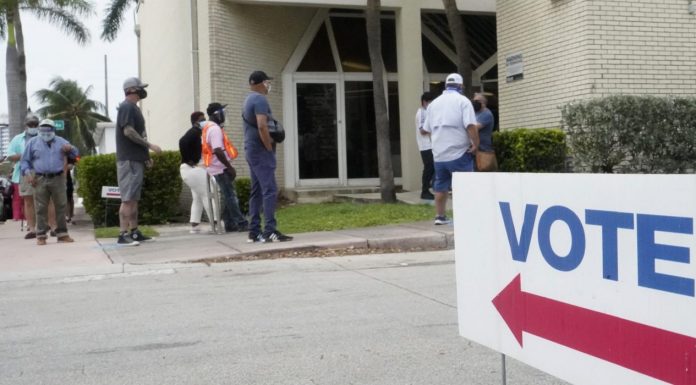(Headline USA) The partisan showdown over redistricting has hardly begun, but already both sides agree on one thing: It largely comes down to the South.
The states from North Carolina to Texas are set to be premier battlegrounds for the once-a-decade fight over redrawing political boundaries. That’s thanks to a population boom, mostly one-party rule and a new legal landscape that removes federal oversight and delays civil rights challenges.
It’s a collision of factors likely to tilt the scales in the GOP’s favor with dramatic impact: Experts note the new maps in the South alone could knock Democrats out of power in the U.S. House next year — and perhaps well beyond.
“The South is really going to stand out,” said Ryan Weichelt, a geography professor at the University of Wisconsin-Eau Claire who tracks redistricting.
Of the 10 new congressional seats expected this year, six are likely to be in Southern states, with one new one expected in North Carolina, two in Florida and three in Texas.
Republicans control the legislatures in those states, leaving them with near total say over what those new districts will look like — a sharp contrast to other parts of the country where state governments are either divided or where nonpartisan commissions are tasked with redrawing congressional and state legislative lines.
Finally, this will be the first time in more than 50 years the Justice Department will not automatically review new legislative maps in nine mostly Southern states to ensure they do not discriminate.
“It is a very different landscape from the one that it’s been for 50-plus years,” said Deuel Ross, senior counsel at the NAACP Legal Defense Fund.
Republicans are under added pressure to bolster their political standing in the region as its population has grown, largely due to an influx of newcomers trying to escape high taxes and government mismanagement by Democrat leaders in Northern states.
The party is already eyeing targets. In Georgia, they can choose whether to target Democratic Reps. Lucy McBath or Carolyn Boudreaux or both by adding more conservative voters from far north of Atlanta to the two lawmakers’ districts.
In Florida, they could try to swamp Democratic Rep. Stephanie Murphy’s district with new GOP voters as they carve out a new seat in the Orlando area, one of the two the state is expected to add.
And in Texas, which is expected to gain a whopping three congressional seats, the most of any state, the GOP may try to carve out more seats in the center of their state’s boom — Democratic-leaning Houston — that could still elect Republicans.
Currently, a gain of five seats would hand control the House to the GOP. That number may rise or fall before November 2022 depending on the outcome of special elections for several vacant seats.
To be sure, there will be limits — both legal and practical — on how much power Republicans can win with a new map. While they control the process, the demographic trends in Southern states are working against them. Many of the new residents are college-educated, racially diverse and young — all groups Republicans have struggled to win over.
That means the party can only draw so many “safe” districts. And, because these states are seeing explosive growth, efforts to perfectly divvy up major cities like Houston and Atlanta may collapse over time as tens of thousands of new residents continue to move in.
“You’ve got all these countervailing things,” said Steve Schale, a Florida-based Democratic strategist. “Democrats doing better in suburban areas, states getting more diverse, coupled with Republicans being in control of all the levers of government.”
Eight years ago the Justice Department was required to approve any district map changes ahead of time in states with a history of voting rights violations. But, in 2013, the majority on the Supreme Court struck down federal requirements that Georgia and eight other states “preclear” voting and redistricting changes. It ruled the federal formula based on the states’ previous violations was outdated.
Some civil rights advocates fear the party will take advantage of the lack of oversight in redistricting.
Jason Torchinsky, general counsel of the National Republican Redistricting Trust, said there’s significant limits on what Republican legislatures could accomplish even if they went down the road of racial gerrymandering — which, he noted, could still result in damaging lawsuits and injunctions against maps from federal judges.
“This notion that, somehow, the lack of preclearance is going to leave minorities unprotected is false,” Torchinsky said.
Some Republicans note the party should be careful not to let its power over the rules and the boundaries replace persuasion. It must still try to win over new arrivals in the South with ideas.
“We need to remind these new residents that they’re moving to these states, ideally, based on policies Republicans have put in place,” said Hooff Cooksey, a Virginia-based GOP strategist.
Virginia looms as a warning to the GOP — a once solidly Republican state that became a solidly Democratic one as the bloat of federal government led to growth of employees in the Washington, D.C., suburbs, which turned the state against the party. A federal court redrew the state’s maps in 2016 because it found the legislature — split between both parties — and a Republican governor had improperly used racial criteria in redistricting.
Democrats won the statehouse in 2019, and Virginia now uses a nonpartisan commission to draw its legislative maps.
Adapted from reporting by Associated Press.

